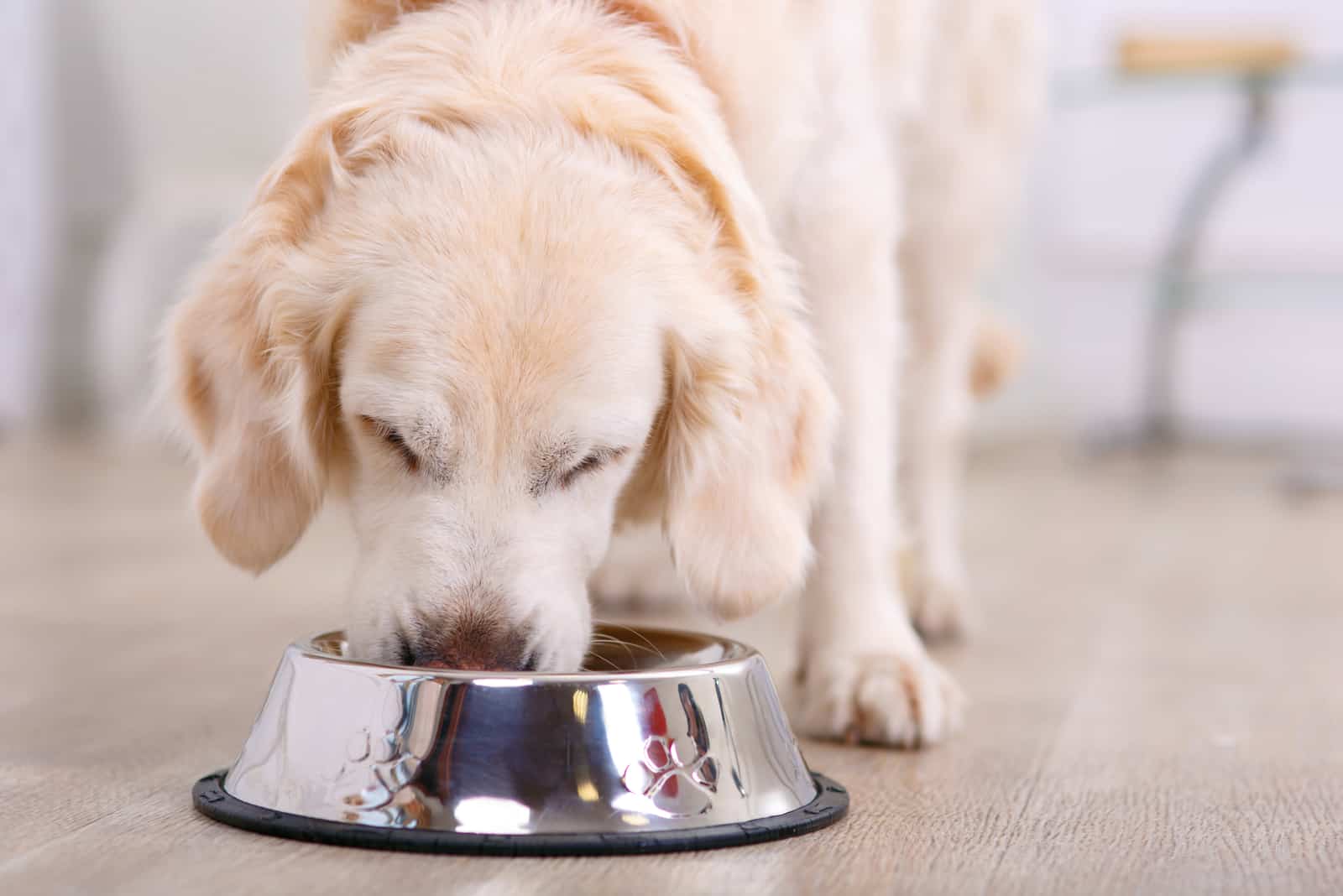Okay, let’s begin by putting your mind at rest: if you’ve found an empty Fig Newton wrapper, cookie crumbs, and a guilty-looking dog, don’t panic!
A few Fig Newtons shouldn’t do your dog any lasting harm.
It all depends on the age and size of your dog, their general health, and the number of cookies consumed. Assuming that your dog is relatively healthy and youthful, and hasn’t eaten its body weight in Fig Newtons, then all should be well.
Even so, it’s best to avoid giving your dog these chewy, tasty treats too often. Although one or two cookies (or bars) once in a while won’t make your dog sick, they’re not the best treat to use on a regular basis.
We’ll explain why this is further along, so keep reading to discover more about human foods and our doggy friends. First, we’ll give a comprehensive answer to the question, can dogs eat Fig Newtons?
Can Dogs Eat Fig Newtons? Let’s Look At The Ingredients

When asking Can dogs eat Fig Newtons? The assumption is that we are talking about the branded cookie made by Nabisco. However, many people use the same name for other brands (usually called fig rolls to avoid trademark rules) or homemade versions.
Whatever the brand, or even if your Fig Newton cookies are homemade, it’s the ingredients we need to examine for anything that might harm your dog.
As snacks go, the Nabisco Fig Newton is pretty healthy (for humans) compared to other snacks and cookies. Even so, they do contain a lot of sugar.
Here are the first five ingredients in the real thing:
• Whole grain wheat flour
• Figs
• Sugar
• Fructose corn syrup
• Invert sugar
The first two aren’t so bad, as they are the main ingredients. Whole grain wheat flour and figs are two healthy ingredients on the whole.
But then we have three different types of sugar, which isn’t so good. This means that two cookies (considered one serving) contain 12g of sugar and about 100 calories.
Fructose corn syrup is public enemy number one when it comes to the worst ingredients you can put in food. Admittedly, it’s not as unhealthy as high-fructose corn syrup, but it’s still not something you want to eat regularly.
This ingredient is a major cause of obesity in humans and will have the same effect on your dog. It can also cause hyperactivity and diabetes in dogs.
Also, although whole grain wheat flour is typically considered healthy, some dogs are allergic to wheat.
Oddly enough, the symptoms might lead you to believe that your puppy has an ear infection, as they’ll shake their head from side to side, pawing at their ears. They may also vomit or develop a rash inside the mouth. If you spot these symptoms, it’s best to act quickly in case your dog goes into anaphylactic shock.
Some of the other ingredients are bad news for dogs as well:
• Hydrogenated cottonseed oil (and palm oil or canola oil). The process of hydrogenation creates trans-fats that can raise ‘bad’ cholesterol. Also, palm oil is toxic to dogs.
• Artificial flavors. Note that few ingredients ever state what these are. We’ll mention these again later.
• Preservatives (including Sulfur dioxide). Again, the preservatives are often not listed, but sulfur dioxide is known to cause vitamin B1 deficiency in dogs, proving fatal in many cases.
One ingredient that may cause concern is baking soda. Some sources claim that baking soda is highly poisonous to dogs, and this is, in fact, true. However, these studies refer to the substance in its powdered state before being used in cooking.
The amount of cooked baking soda in a single Fig Newton won’t have any adverse effects on your pup.
Finally, salt appears about halfway down the list of ingredients, meaning that there’s a fair amount (ingredients are listed in order of volume). Too much salt can damage your dog’s health, leading to dehydration and sodium-ion poisoning. A dog’s body is around 80% water (like humans) but can quickly become dehydrated.
This starts with an increase in urination, followed by seizures, tremors, and a high temperature. Your dog may also suffer from vomiting and diarrhea, and severe cases of salt poisoning can be fatal.
Can Dogs Eat Figs?

We’ve pointed out that dogs can eat those delicious cookies containing figs, but what about the fruit that makes the gooey filling itself? Are figs safe for dogs? After all, it won’t have any of the other ingredients, like sugar, soy, corn syrup, or wheat in it.
The short answer is yes, but dogs should eat this fruit in moderation!
As figs are the second most prominent ingredient in Fig Newton cookies, we should look at any potential dangers or health benefits of this fruit.
Fresh figs are a super-healthy food and a great addition to the human diet. Figs are a low-calorie, high-fiber fruit, making them ideal as part of a balanced diet. Figs are also naturally free from cholesterol and fat, making them great for weight loss.
They contain potassium, magnesium, and calcium, essential for healthy bones. Figs also contain vitamins A, C, K, and B6, which help keep the immune system running smoothly. They also help regulate blood pressure, boost cell growth, and improve reproductive health.
The high-fiber content in figs helps regulate blood sugar levels, keeps the digestive tract working properly, and promotes healthy bowel movements. Figs have always been a traditional cure for constipation.
So, do these benefits apply to our furry pals too?
In a way, yes, they do.
However, most dogs can’t handle the high levels of dietary fiber, which could cause an upset stomach. Also, some dogs are sensitive to ficin, an enzyme inside figs that can cause an allergic reaction.
This is a vitally important issue if you have a fig tree in your garden or parks nearby. Figleaves, unripe fruit, stems, and bark contain high amounts of ficin and fucosin, which is toxic to dogs.
Fig poisoning is a real possibility if you have a fig plant, so be sure to watch that your dog doesn’t go too close.
Now, back to the fruit itself and whether dogs can eat them.
Fresh figs are healthy, and your dog will benefit from eating them in moderation. It’s best to keep to a maximum of two figs a week, or you risk giving your dog diarrhea.
Also, it’s better to use fresh rather than dried figs, as these are higher in calories and natural sugar content. Eating too much sugar risks serious health issues.
Can Dogs Eat Strawberry Fig Newtons?

Without wishing to be pedantic, there’s no such thing!
There are Fig Newtons (or fig rolls), and then there’s the strawberry-filled variety that doesn’t contain any figs at all!
Now we’ve cleared that up, let’s continue with our mission.
As well as the strawberry variety, Nabisco also released raspberry, mixed berry, and apple cinnamon. So, can dogs eat them?
At first glance, there doesn’t seem to be any problem with dogs eating any of these. After all, they’re healthy fruits that don’t pose any danger to your dog’s health.
However, it’s the high sugar content that puts a spanner in the works once again. Although these tasty treats contain fruit, it’s in a paste form that includes a heap of sugar.
It doesn’t matter what the food is; anything with a high amount of sugar is wrong for your dog. Eating sugary foods regularly will have a negative impact on their health, if not immediately, then definitely in the long term.
The effects differ depending on the size and age of your dog. Tiny dogs and young puppies are already at risk of hypoglycemia as their bodies don’t have the fat reserves needed to balance their blood sugar levels.
So, a Chihuahua might be in danger after eating a couple of cookies, while it would have no effect on an adult German Shepherd.
Most dog breeds are at risk of obesity, but energetic dogs that don’t get enough exercise are more prone to being overweight as excess energy is stored as fat.
When you throw in sugary treats, you have a recipe for obesity, diabetes, heart disease, joint problems, cancer, breathing difficulties, and a reduced lifespan.
The Hidden Dangers In Human Foods

It’s wise to be aware of which human foods are safe to feed your dog and which ones to avoid. Many of the things we eat are toxic to dogs, and some can be fatal.
We’ve already mentioned salty and sugary foods, and it’s best to avoid giving these to your dog at all.
However, many other hidden dangers in our food can cause our beloved pooches severe damage. Here are some that you should avoid at all costs:
• Garlic (and any member of the onion family) is toxic and causes red blood cell damage.
• Chocolate contains theobromine that can cause kidney failure.
• Grapes, raisins, and golden raisins (or sultanas) also cause kidney failure and liver damage.
• Xylitol is well known for its extreme toxicity to dogs! It’s an artificial sweetener used in many brands of toothpaste, peanut butter, ice cream, and gum (among other foods).
• Macadamia nuts are harmful due to a toxin that attacks the central nervous system and muscles.
These are a few foods that you should never give to your dog. On top of this, it’s best to avoid giving your dog spicy foods, like chili peppers or anything fried. Table scraps are a big no-no, as they contain large amounts of salt.
Fried or salty foods (bacon and chicken being the worst culprits) can harm your dog within minutes, but the effects can build over the years unseen.
Suddenly, you’ll have a poorly dog on your hands when it succumbs to pancreatitis. Your dog’s pancreas produces enzymes that will cause serious damage to its intestines.
Even though most cases of pancreatitis are mild, there are instances when the damage is too severe.
Many dogs recover fully after about three days, but acute pancreatitis can be fatal. Some vets have been known to euthanize a dog with this condition as it is kinder than allowing them to suffer.
You’ll probably come across blogs and websites offering other opinions concerning dogs and human foods.
Some so-called experts will boast that they’ve fed their dogs these foods for years without any ill effects. The first response to this should be, why would you do this, knowing there was a risk?
Then we should point out that all dogs are different, and some might have a milder reaction than others.
Finally, although these ‘experts’ make bold claims, there’s a good chance that the damage has been building up slowly over the years and will eventually make itself known when it’s too late to do anything about it.
The bottom line? If you really love your dog, don’t give them garbage to eat! Stick to their regular dog food and give them healthy treats. And that doesn’t include giving your dog Fig Newtons.
There are plenty of healthy alternatives designed especially for dogs.
And if you wanted an even more nutritious, natural alternative, why not give your best friend some fresh banana, apple, green beans, broccoli, cooked sweet potato, carrot, or watermelon?
These can be chopped into bite-size chunks and fed as treats or included as a supplement to their usual food.
Introducing New Foods To Your Dog

Photo from: @joy_thebeagle19
Dogs are weird. But every dog owner knows this!
Their perfect pooch will turn its nose up at the best-quality gourmet dog food, then happily chow down on some disgusting and unidentifiable gunk it finds under a bush in the park.
Still, dogs, in general, have highly sensitive digestive systems and are prone to many food allergies and intolerances. If you switch to a new brand of kibble, they’ll look at you as if you’ve gone nuts. Alternatively, they’ll get an upset stomach and regurgitate their dinner on your best rug.
Because of this, it’s always best to introduce new foods gradually.
Whether it’s fresh figs or the odd Fig Newton once in a while, you should offer a tiny amount, to begin with. This allows you time to observe any adverse reactions or changes in behavior.
The first sign to look out for is drooling. Yes, some dogs drool anyway, but this will be continuous and excessive.
Another sign is vomiting, often accompanied by diarrhea. You may notice that their stomach is bloated and is painful to the touch. You should also check for any signs of a rash or dry, scaly skin.
Food allergies or intolerance usually show within an hour of your dog eating the offending item.
This gives you time to watch for symptoms, and this is why it’s good to introduce new foods slowly. A small amount of new food will have a reduced impact on your dog’s system, so the symptoms won’t be severe.
If you don’t detect any adverse effects, you can increase the amount until you are happy that it’s safe for your pooch.
One major cause of food allergies is lactose. Technically, all dogs are lactose intolerant (as are humans, but that’s another matter!) as they don’t produce lactase.
Puppies produce lactase while their mother feeds them. This enzyme breaks down lactose into two separate molecules, allowing it to be digested easily.
Once the pups are weaned onto solid food and no longer suckling, they stop producing lactase (some breeds make small amounts, but not enough to cope with lactose fully).
Because of this, many dogs react badly to lactose as their immune system recognizes the protein as harmful.
Other proteins that can cause problems are beef, chicken, eggs, and lamb.
Can Dogs Eat Fig Newtons? Final Thoughts

Right at the start, we asked, can dogs eat Fig Newtons? And we’ve pretty much covered this subject in full.
By all means, carry on eating Fig Newtons (or any other variety or brand) yourself, although there are healthier snacks out there. Just don’t feed your dog too many.
In fact, it would be best to avoid giving them to your dog altogether, as it’s really not worth the risk.
We have a choice in the foods that we eat. Our furry pals rely on our judgment, and they trust us as the pack leader to provide food for them. It’s only fair to give them the best food possible and to ensure that they have proper nutrition.
It’s fair to say that this could affect your dog’s lifespan.
Around 56% of all dogs in America are classed as obese. While it’s understandable to want to give our pups plenty of food and treats, we aren’t doing them any favors. It’s essential to provide them with the right food for their age, weight, and energy levels.
As they grow older, dogs become less energetic and need less food. Most dog owners continue to dish up the same amount of food they always have done in the past, so the dog puts on weight.
This leads to a downward spiral, as the extra weight makes it harder for the dog to move, so they become less active. You’ll notice that your furry friend ambles slowly and cannot run, and they pant all the time.
The increased pressure on their joints causes arthritis and inflammation, making them less mobile still. Older dogs are also more at risk of cancer, and this often starts in the fat cells in the dog’s belly. And the more fat there is, the more chance of cancer.
It’s a downward spiral that won’t end well unless it’s dealt with while they are young, and it all starts with their diet!
It’s a simple case that if you want your best friend to live longer and stay healthy, you need to cut out unhealthy foods. And that includes Fig Newtons.

